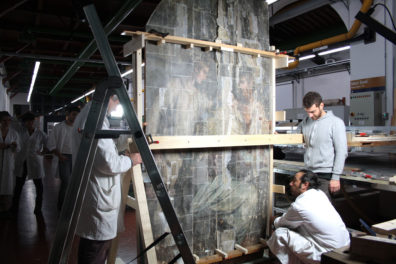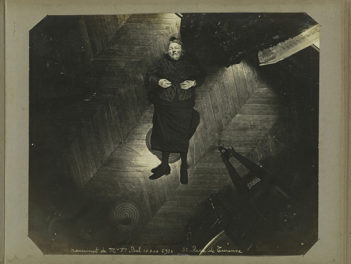
Alfred Stieglitz’s The Hand of Man (negative 1902, print about 1933), an example of a gelatin silver print. The J. Paul Getty Museum, 93.XM.25.7
Scientists at the Getty Conservation Institute have just released the first installment of The Atlas of Analytical Signatures of Photographic Processes. The Atlas features key information and tools for the identification of photographic processes. In addition to serving as a significant resource for the analysis of photographs, the publication captures and re-assembles critical information regarding these historic processes now at risk of being lost during these waning days of traditional chemical photography.
Available for free online, the initial publication of the Atlas provides detailed scientific information on eleven of the most common and important black-and-white photographic processes and process variants (about fifty all told). The publication will be continually updated.
The Atlas is a product of a decade-long Conservation Institute project to develop innovative research methodologies for scientific analysis and identification of more than 150 different photographic processes (and process variants) that were invented, advanced, and sometimes forgotten during the nearly 200-year-long era of chemical photography.
Of course, well-known examples of all these photographic processes exist among the millions of photographs housed in art museums, archives, libraries, and private collections.
But interestingly, the processes by which many of these photographs were created have remained unknown or have actually been misidentified, contributing to incorrect descriptions of the objects. Such misinformation also threatens the long-term preservation of our photographic heritage because proper identification of photographs is essential in specifying appropriate light exposure during an exhibition, conditions for long-term storage, and safe methods of conservation treatment.

An early carbon photograph by Adolphe Brown, Two Girls (detail), date unknown. Private collection
“The Atlas is the first photograph conservation research publication that integrates historical information and ‘inside the darkroom’ techniques of practicing photographers with modern scientific and analytical technology,” said Dusan Stulik, a senior scientist at the Conservation Institute who has been working on the Atlas with researcher Art Kaplan.
In Dusan’s words, “these advanced methods of identifying photographic processes and photographs go well beyond what can be achieved with standard visual and microscopic inspection, and they provide an objective foundation for current and future historical research of photographs.”
The Atlas also was created to establish a bridge between the photograph conservation and conservation science communities.
Few photograph conservation laboratories or private photograph conservators have easy access to well-equipped conservation science laboratories with scientists experienced in the analysis and identification of photographs. But many conservators have access to university or industrial laboratories that could perform the needed analysis if they have guidance on the interpretation of results. It’s hoped that the Atlas will stimulate exchange and communication between scientists and conservators as they jointly tackle analytical questions regarding a photograph’s material composition and the process by which it was produced.
Future installments and periodic updates to the Atlas will include additional photographic processes, as well as new information about processes already contained in the publication.
The aim of Conservation Institute scientists is to make the Atlas a comprehensive reference of well-researched, experimentally tested, and objective data on the photographic processes and important process variants of the chemical photography era.
The Atlas is currently available as a series of PDFs. In the future, the Conservation Institute hopes to make it available in an interactive format that allows for querying, manipulation, and interpretation. The Institute also is seeking feedback from the community of Atlas users to determine the most useful media format.




Comments on this post are now closed.